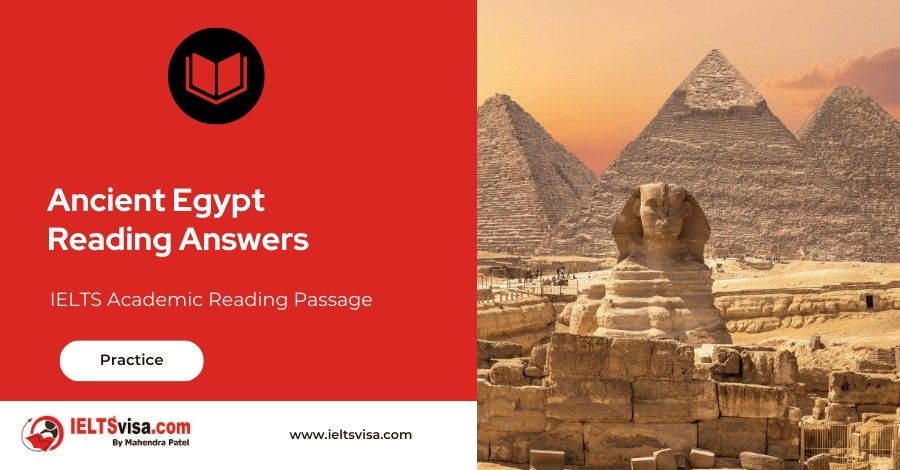Ancient Egypt Reading Answers
IELTS Academic Reading Passage
The people of ancient Egypt emerged as one of the first Western civilisations. Sustained by the River Nile and protected by vast deserts, the Egyptians lived in comparative security, prosperity and peace for thousands of years. When such conditions exist, civilization and its arts usually flourish. To this day, many of the Egyptian artistic creations display the wealth, splendour and talent of this great civilisation.
Ancient Egypt has been called a land of temples and tombs, and for centuries people have been filled with wonder at the ingenuity of the Egyptians, whose impressive works have withstood the ravages of time so well. Had it not been for the long-lasting nature of their monuments and carved inscriptions in the form of hieroglyphics’, much evidence of their activities would have vanished from all historical records. In about 3000 BC, Upper and Lower Egypt were united under the first pharaoh, and generally, from that time until the invasion by Alexander the Great in 332 BC, Egypt prospered as a nation of skilful craftsmen and artists.
The Egyptians were industrious, highly civilised and deeply religious people, who obediently accepted the supreme authority of their pharaohs. The people were content to serve and work for the state in return for a secure livelihood. They considered this earthly life to be a segment in a great cycle, at the end of which everything would be returned to its original form. The richer and more important the person, the more careful and elaborate would be his or her burial, and the stronger and safer the tomb in which they would be buried.
The burial of the dead in the ground was not considered sufficiently safe for kings, queens and court officials, so sunken, sealed tombs were ingeniously constructed to protect personal treasures, food and instructions for the safe conduct of the soul after death. The design of these tombs developed into the stepped pyramid, and finally into the square pyramid that we know today.
There are about 80 ancient pyramids in Egypt. The Great Pyramid at Gizeh, which King Cheops built as his tomb 5000 years ago, holds the most interest. It stands with two other pyramids on a slight rise overlooking the River Nile. At the centre of the pyramid is the King’s Chamber and leading down from there is a long narrow area known as the Grand Gallery. The pyramid covers 13 acres and contains 2,300,000 blocks of limestone, each weighing an average of 1.5 tons. Its pyramidal form has a perfectly square base with sides of 756 feet and a height of 481 feet. Situated directly below the King’s Chamber is the Queen’s Chamber and there are two air channels leading upwards from the centre of the pyramid to the outside.
Originally, the exterior was covered in highly polished limestone slabs, all of which have been stolen over the years. It is estimated that a total of 100,000 men laboured for 20 years to build this gigantic structure, and although architecturally unimportant in design, it has aroused the curiosity of millions of people because of the uncanny accuracy of its measurements and proportions. It reveals the remarkable ingenuity and the great organising ability of the ancient Egyptians.
Near these pyramids stands the Great Sphinx, the origin and purpose of which constitute one of the world’s most famous puzzles. Shaped from an outcrop of stone in the form of a human-headed lion, the face is possibly a portrait of King Khafra, the son of Cheops, who was buried in the second largest pyramid. The Sphinx is one of the biggest statues ever made.
The Egyptian people showed reverence towards natural objects such as the lotus flower, the scarab beetle, the falcon, the lion, the sun and the River Nile. AII these subjects and many more were used symbolically and conventionally as motifs in low-relief carving and painting. It was the custom of the Egyptians to depict the various parts of the human figure, usually in the most characteristic positions. The head was shown in profile except for the eye, which was represented from the front, the shoulders and a portion of the arms were portrayed from the front, while the hips and legs were side views. Wall decoration showed little or no attempt to indicate depth or perspective, except by placing distant objects above near things. It was essentially two-dimensional, and relative size indicated the status of the person, so the pharaoh was the largest figure in the composition.
Egyptian art is characterised by a passion for permanence, a desire to impress by size, and a determination to make each item serve its function without much regard for the whole. It is obvious that art among these people reached a very high level and the strong influence of Egyptian art can be seen in the work of nearby civilisations.
The fortunate discovery and subsequent deciphering in 1822 of the Rosetta Stone, which showed the same laws inscribed both in Egyptian hieroglyphics and the Egyptian demotic, or popular version of their language, as well as the Greek language, eventually gave the key to the meaning of Egyptian inscriptions, and therefore the significance of much Egyptian art.
Questions 1-3
Complete the sentences below.
Choose NO MORE THAN THREE WORDS from the passage for each answer.
Write your answers in boxes 1-3 on your answer sheet.
1 Security and peace are two …………………… that are necessary for a civilization to be successful.
2 Ancient Egyptians worked as both……………………. .
3 Ordinary Egyptians expected to receive …………………… for their hard work.
Questions 4-7
Label the diagram below.
Choose NO MORE THAN THREE WORDS AND/OR NUMBERS from the passage for each answer.
Write your answers in boxes 4-7 on your answer sheet.

4 ……………………………………………
5 ……………………………………………
6 …………………………………………..
7 ……………………………………………
Questions 8-12
Do the following statements agree with the information given in the Reading Passage?
In boxes 8-12 on your answer sheet, write
TRUE if the statement agrees with the information
FALSE if the statement contradicts the information
NOT GIVEN if there is no information on this
8 The surface of the Great Pyramid is covered in polished limestone slabs.
9 King Khafra died before King Cheops.
10 Egyptian carvings were often based on things found in nature.
11 Important characters in Egyptian carvings were bigger than less important characters.
12 Egyptian art was greatly influenced by the art of neighbouring cultures.
Question 13
Choose the correct Ietter – A, B, C or D.
Write the correct letter in box 13 on your answer sheet.
13 The writer’s aim in this passage is to
A describe the construction methods of the pyramids.
B explain the beliefs of the ancient Egyptians.
C offer an interpretation of Egyptian art and sculpture.
D provides an overview of early Egyptian society.

Solution For: Ancient Egypt
Reading Answers
| 1. conditions | 8. FALSE |
|---|---|
| 2. craftsmen and artists / artists and craftsmen | 9. NOT GIVEN |
| 3. a secure livelihood | 10. TRUE |
| 4. (the) Grand Gallery | 11. TRUE |
| 5. 481 feet | 12. FALSE |
| 6. (the) Queen’s Chamber | 13. D |
| 7. (the) air channel(s) |
Review and Practice
- Regularly practice with IELTS reading samples and time yourself to get used to the pressure of the exam.
- Review your mistakes to understand where you went wrong and how to avoid similar errors in the future.
Our Books
Master IELTS Speaking Part 1
IELTS Writing Task 1 Book
IELTS Writing Task 2 Book
Ancient Egypt Reading Answers Explanation
Comin Soon
Practice IELTS Other Modules
IELTS Listening
The IELTS Listening test assesses how well you can understand spoken English in various contexts. It lasts about 30 minutes and is divided into four sections with a total of 40 questions. The listening tasks become increasingly difficult as the test progresses.
IELTS Academic Reading
The IELTS Academic Reading section assesses your ability to understand and interpret a variety of texts in academic settings. It is designed to evaluate a range of reading skills, including skimming for gist, reading for main ideas, reading for detail, understanding inferences, and recognizing a writer's opinions and arguments.
IELTS Speaking
The IELTS Speaking test assesses your ability to communicate in English on everyday topics. It lasts 11-14 minutes and consists of three parts: introduction, cue card, and a discussion based on the cue card topic.
IELTS General Reading
IELTS General Reading tests your ability to understand and interpret various types of texts. Here are some key areas and types of content you can expect to encounter in the reading section, along with tips for effective preparation.
IELTS Academic Writing Task 1
In IELTS Academic Writing Task 1, you are presented with a visual representation of information, such as graphs, charts, tables, or diagrams, and you are required to summarize, compare, or explain the data in your own words.
IELTS General Writing Task 1
In IELTS General Writing Task 1, you are required to write a letter based on a given situation. The letter can be formal, semi-formal, or informal, depending on the prompt. Here’s a breakdown of the key components to include in your letter
IELTS Academic Writing Task 2
In IELTS Academic Writing Task 2, you are required to write an essay in response to a question or topic. Here’s a guide to help you understand the essential elements of this task
IELTS Exam Tips
To succeed in the IELTS exam, practice regularly, familiarize yourself with the test format, improve your vocabulary, develop time management skills, and take mock tests to build confidence.
Grammer for IELTS
Grammar is the foundation of effective communication in English. Understanding tense usage, subject-verb agreement, and sentence structure enhances clarity and coherence in writing and speaking.
Vocabulary for IELTS
Vocabulary plays a crucial role in the IELTS (International English Language Testing System) exam, especially in the Speaking and Writing sections. Here’s an overview of why vocabulary is important and how it impacts your performance
RECENT IELTS SAMPLES QUESTIONS AND ANSWERS
Ebonics Reading Answers
A. Ebonics - also known by a host of other names such as African American Vernacular English,...
A Disaster Of Titanic Proportions
A. At 11:39 p.m. on the evening of Sunday, 14 April 1912, lookouts Frederick Fleet and...
Vitamins To supplement or not?
Mineral, vitamin, and antioxidant health supplements make up a multi-billion-dollar industry...
The Hollywood film industry
A. This chapter examines the ‘Golden Age’ of the Hollywood film studio system and explores how...
Three Dimensional Films Reading Answers
A. In the theatre of the Ambassador Hotel in Los Angeles, on the evening of 27 September 1922,...
The Developing World Reading Answers
A THE DEVELOPING WORLD — the economically underdeveloped countries of Asia. Africa. Oceania...













